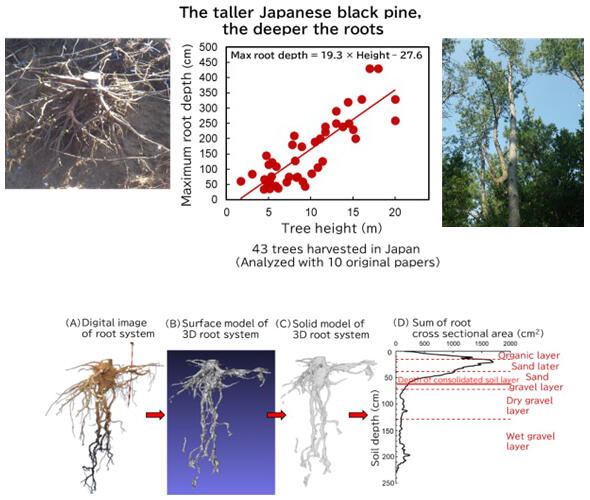Black pine (Pinus thunbergii) trees have long been planted on beaches in Japan because they exhibit high resistance to strong winds, sea salt, and tsunamis. These features are beneficial for disaster mitigation against tsunamis and strong winds, but why has the black pine been chosen? A research group led by Professor Yasuhiro Hirano of the Graduate School of Environmental Studies and Associate Professor Toko Tanikawa of the Graduate School of Bioagricultural Sciences at Nagoya University, in collaboration with the University of Fukuchiyama, Hyogo Prefectural Technology Center for Agriculture, Forestry and Fisheries, University of Hyogo, and Kyoto University, has newly revealed that the root systems of black pine trees planted in coastal areas grow by adapting to the soil environment and that taller trees have deeper roots. The findings are expected to find application in the regeneration of coastal forests with high disaster mitigation functions. The study was published in the Journal of Forest Research.

Provided by Nagoya University
The research group excavated black pine root systems growing on the coast of Tahara City, Aichi Prefecture, and measured the maximum root depth along with aboveground plant traits and soil characteristics. They acquired digital image data on-site immediately after excavation, attempted to reproduce the root system structure in the laboratory, and evaluated the relationships of the root system structure with aboveground plant traits and soil properties. In the analysis, they also incorporated the results of studies on the relationships of these factors with the maximum root depth in black pine root systems excavated in Japan.
Among aboveground plant traits and soil characteristics, the maximum root depth of black pine trees excavated in a coastal forest in Tahara City, Aichi Prefecture, showed the strongest association with tree height. This relationship was found to be valid for 43 black pine individuals excavated in Japan. In other words, the maximum root depth can be estimated from tree height in black pine.
By creating a surface model and a solid model of the root system structure from root system digital images taken immediately after excavation, they enabled reproduction of the three-dimensional structure of the root system. Using this method, reanalysis and data storage of large, complex root system structures became possible by storing digital data images on-site without bringing large root system samples back to the laboratory.
The analyzed changes in the sum of the root cross-sectional area with soil depth corresponded well with soil layers such as sand and gravel, revealing that roots grow in accordance with the soil environment. Shallow-rooted black pine trees in coastal forests that were severely damaged by the tsunami associated with the Great East Japan Earthquake have fallen over a wide area. Therefore, for the regeneration of the coastal forests, black pine trees were planted on the earth-mounded growing base to ensure sufficient root depth.
In some areas, however, the planted black pine trees showed poor height growth and had limited root depths due to the hardness of the mounded earth and the high groundwater level. In these areas, specific management methods to induce deeper root development for shallow-rooted black pine trees with low tree height, such as softening the soil and improving water drainage, must be established to improve the disaster mitigation function. The method developed in this study is also effective for this purpose.
Journal Information
Publication: Journal of Forest Research
Title: Intraspecific variation in root system structure in a Pinus thunbergii stand grown in a gravelly spit coast
DOI: 10.1080/13416979.2024.2431756
This article has been translated by JST with permission from The Science News Ltd. (https://sci-news.co.jp/). Unauthorized reproduction of the article and photographs is prohibited.




